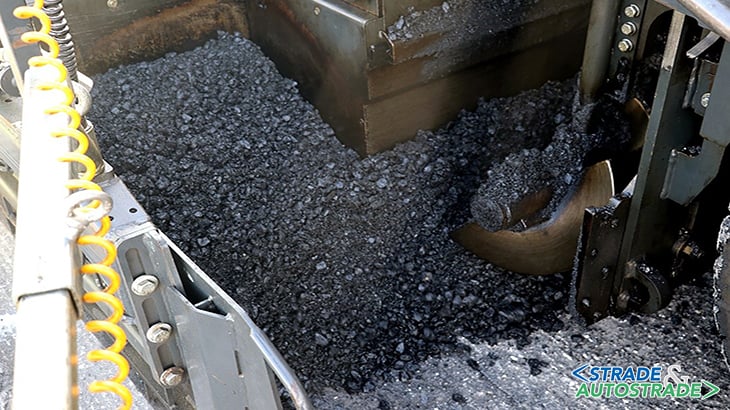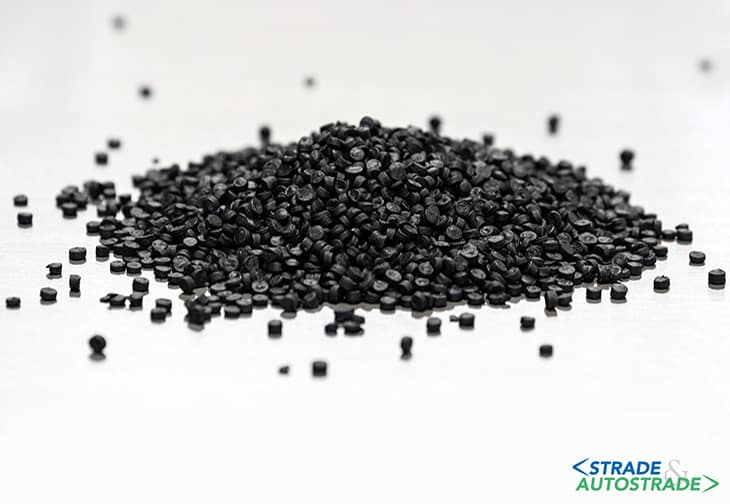Graphene-enhanced supermodifiers for eco-sustainable and perpetual pavements – part two ![]() Per la versione in Italiano: https://www.stradeeautostrade.it/asfalti-e-bitumi/supermodificanti-a-base-di-grafene-per-ecosostenibilita-e-pavimentazioni-perpetue-seconda-parte/
Per la versione in Italiano: https://www.stradeeautostrade.it/asfalti-e-bitumi/supermodificanti-a-base-di-grafene-per-ecosostenibilita-e-pavimentazioni-perpetue-seconda-parte/
In part one of the article, published on issue n. 140 Marzo/Aprile 2020 and https://www.stradeeautostrade.it/asfalti-e-bitumi/supermodificanti-a-base-di-grafene-per-ecosostenibilita-e-pavimentazioni-perpetue-prima-parte/ we debated the theorical aspects; in part two (and last) we will speak about the application.
From research to application
If, on the one hand the Green and Circular Economy move towards the reuse and recycling of end-of-life products, on the other hand we must not forget that, when it comes to asphalt pavements, safety takes the first place, i.e. the assurance of the work performances.
The road therefore should not become a “landfill” or a “repository” of disused materials. This means that, the materials used in the construction must be subjected to an adequate technical-environmental study.
Therefore, even at Dry modifications, the use of polymeric compounds cannot be done generally without defining a project of research and development. The Ecopave Project has included:
- product development in the R&D chemical laboratory;
- verification of the use in asphalt layers by laboratory analysis;
- the execution of real-size trial sections, after prequalification phase of the mix design;
- the post-production verification of the modified asphalt using both laboratory and on site tests, carried out by Official Laboratories and Universities;
- monitoring the trial section over time;
- the verification of LCA, even with on-site surveys on emissions and energy consumptions.
It is quite clear that, in addition to the various years of study, this process has required major investments in equipment and human resources, but this was the only possible way to guarantee the quality and the final product performances.

Life Cycle Assessment (LCA)
The Life Cycle Assessment (LCA) was conducted according to regulations UNI EN ISO 14040-14044, by comparing the new graphene-based super modifier with the other common production technologies (use of standard bitumen or PmB), examining and quantifying the potential environmental impacts along the entire production chain, up to the reuse of the end-of-life asphalt.
The system boundaries analysed, concern the extraction, processing and transportation of raw materials, the use of different materials (bitumen, polymers and polymeric compounds), the production of asphalt, adopting different technologies, demolition and reconstruction operations of the road in the various maintenance cycles, the reuse through the rejuvenation of the asphalt mix granulate deriving from the milling of the existing road superstructure (in the percentages allowed on average by the technical specifications of CSA).
The functional unit of reference was a 15 m wide and 1 km long extra-urban road. The analysis was conducted for the road section consisting of the following asphalt layers: base, binder and wearing course.
The adopted calculation methodology is the “Environmental Footprint” that includes the following impact categories:
- global warming;
- eutrophication;
- carcinogenic and non-cancerous effects on human health;
- eco-toxicity;
- reduction of the ozone layer;
- resources and land use;
- photochemical formation of the ozone layer;
- acidification;
- respiratory diseases;
- water use and ionising radiation.
LCA’s results show the considerable increase in the mechanical performances and, consequently, the extension of the pavement’s estimated service life. The graphene-based super modifier adopting Dry-method technology turns out to have lower impacts compared to the other technologies, for all the impact categories listed above.
In addition to the LCA analysis, the releases into the environment were also examined including emissions in the atmosphere, the releases in water and those of microplastics. All the obtained results complied with the specs in line with LCA positive results (they will be published soon).
Road tests
With the aim of validating the excellence of the graphene-enhanced supermodifier, it was verified on a large scale with the execution of trial sections.
The product was trialled for the first time on a section of road at the end of 2018. After that, several trial sections were conducted both in Italy and in the U.K., and they involved different types of asphalt pavements as followings:
- Metropolitan City of Rome – S.P. 3 “Ardeatina” (heavy-traffic extra-urban road): the project was part of the extraordinary maintenance programme that was in progress and it consisted of both binder and wearing courses. The technologies applied for the asphalt mixes production were:
- standard bitumen;
- modified bitumen with SBS (hard type);
- standard bitumen with addition of the polymeric compound called Superplast low modification Dry method;
- standard bitumen with addition of the super modifier called Gipave® (Dry method);
- Metropolitan City of Milan – S.P. 35 “Milano-Meda” (heavytraffic extra-urban road): the project consisted of Base, Binder and Wearing Courses. The technologies for the production of the asphalt mixtures were:
- modified bitumen with SBS (super-hard type);
- standard bitumen with addition of Gipave® supermodifier (Dry method);
- City of Bergamo – Ring-road (heavy-traffic extra-urban road): the project was part of the asphalt pavement reconstruction and consisted of Base and Wearing Courses. The technologies for the production of asphalt mixes were:
- modified bitumen with SBS (hard type);
- standard bitumen and addition of the supermodifier Gipave® (Dry method);
- Città Metropolitana di Milano – S.P. 40 “Lacchiarella” (heavy traffic extra-urban road): the trial section was part of the project of asphalt pavement resurfacing consisted of Base and Wearing Courses. The technologies for the production of asphalt mixes were:
- non-modified bitumen;
- modified bitumen with SBS (soft type);
- non-modified bitumen with addition of Gipave® supermodifier (low modification applying Dry method);
- Oxfordshire County-Curbridge (heavy-traffic main urban road): the intervention was part of the project of road resurfacing consisted of Binder and Wearing Courses. The technologies for the production of asphalt mixes were:
- non-modified bitumen with addition of Gipave® supermodifier (low modification applying Dry m bitumen;
- non-modified bitumen with addition of Gipave® supermodifier (low modification applying Dry m bitumen with addition of Gipave® supermodifier (low modification with Dry method);
- International Airport of Cagliari – “Elmas” (Connection K): the project was part of the ordinary maintenance consisted the laying of Wearing Course. The technologies for the asphalt mix production were:
- modified bitumen with SBS (hard type);
- non-modified bitumen with addition of Gipave® super modifier (metodo Dry);
- Intercontinental Airport of Rome – Fiumicino (Taxiway Alpha Alpha): the intervention was part of the project of runway resurfacing that consisted of Base, Binder and Wearing Courses. The technologies for the asphalt mix production were:
- modified bitumen with SBS (hard type);
- non-modified bitumen with the addition of Gipave® super modifier (Dry method).
Each trial section included the pre-qualifying studies of the related mixtures, using the bitumen and aggregates of the project. Official third-party Laboratories and Universities carried out Pre and post-production tests.
Impressive performance
For evaluating the performance of the asphalt containing the graphene-enhanced supermodifier referring to the first trial section (conducted at the end of 2018), the results of the mixtures for the wearing course were obtained from an official laboratory having both laboratory and on-site controls as shown below.
In particular, the following mixtures were investigated:
- standard bitumen (neat) with graphene-enhanced polymeric compound (GP);
- standard bitumen with traditional polymeric compound (“soft” modification – SU);
- modified bitumen with SBS (“hard” modification – MB);
- standard bitumen (TQ).
Figures from 3 to 9 show the obtained test results that highlight:
- a) increase in tensile strength (ability to absorb major deformations before breaking and therefore triggering the cracking phenomenon, with particular reference to bottom-up upwelling);
- b) increase in the stiffness modules (ability to distribute loads in a more efficient and effective way);
- c) rutting reduction (better resistance to permanent deformation);
- d) increase in fatigue resistance (ability to withstand load cycles);
- e) assurance of the adherence between tyre and road surface that depends exclusively on the micro and macro texture of the aggregates.
It should be noted that the performances of an asphalt mix are simultaneously linked to all the properties listed in the previous points (for example, the simple increase in stiffness with a possible reduction of fatigue cycles and in tensile strength, would make the pavement fragile).
In the case of the graphene-enhanced supermodifier, the general improvement of all the physical/mechanical properties allows to obtain a highly-resistant asphalt pavement, with a significant increase in the service life under the same conditions of loads and compared to the technologies that are traditionally used.
Conclusion
If the necessity for high-performance asphalt pavements is constantly increasing given the traffic growth and the load weights, during the last years the Circular Economy and Eco-sustainability have led us, to find technological solutions that allow to reuse materials and extend the pavements’ service life as well.
The research developed in collaboration with the University of Milan-Bicocca, Directa Plus and G.Eco was part of the Ecopave Project 2014-2020, funded by Regione Lombardia, resulted in the formulation of a graphene-enhanced super modifier for Dry modification of asphalt mixtures.
This research process concluded in three patents: Gipave® formulation, grafene G+ production process and “hard” plastics processing.
Post-laying verifications that were carried out by an official laboratory point out the following performance improvements of the asphalt mixture containing the graphene-based Polymeric Compound (GP).
The graphene-enhanced super-modifier allows to extend the service life of the asphalt pavements compared to the technologies, which have been used so far and to recycle part of hard plastics that are usually destined to waste-to-energy plants.
Moreover, the LCA (from cradle to cradle) highlights that the recycling of hard plastics and the use of graphene results in significantly reduced impacts. The environmental gain is remarkable, particularly regarding the categories and the “Global Warming Potential”.
The full LCA analysis and all the results regarding the environmental releases, emissions and those of micro-plastics, will be published soon, complying with what is required by the LCA.
Graphene-enhanced supermodifiers for eco-sustainable and perpetual pavements – part two ![]() Per la versione in Italiano: https://www.stradeeautostrade.it/asfalti-e-bitumi/supermodificanti-a-base-di-grafene-per-ecosostenibilita-e-pavimentazioni-perpetue-seconda-parte/
Per la versione in Italiano: https://www.stradeeautostrade.it/asfalti-e-bitumi/supermodificanti-a-base-di-grafene-per-ecosostenibilita-e-pavimentazioni-perpetue-seconda-parte/

